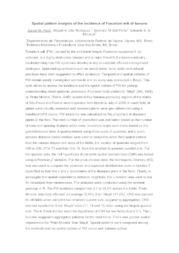Spatial pattern analysis of the incidence of Fusarium wilt of banana.
Spatial pattern analysis of the incidence of Fusarium wilt of banana.
Autoria: HECK, D. W.; RODRIGUEZ, M. A. D.; DEL PONTE, E. M.; MIZUBUTI, E. S. G.
Resumo: Fusarium wilt (FW), caused by the soil-borne fungus Fusarium oxysporum f. sp. cubense , is a highly destructive disease and a major threat to the banana industry. Understanding how FW epidemics develop is key to establish efficient management strategies. Epidemiological factors such as weevil borer, wind, water and cultural practices have been suggested to affect epidemics. Temporal and spatial patterns of FW remain poorly investigated worldwide and no study was conducted in Brazil. This work aimed to assess the incidence and the spatial pattern of FW for gaining understanding about epidemic processes. Fourteen fields planted to ?Maçã? (Silk, AAB) or ?Prata Mineira? (Pome, AAB) located at four banana-producing regions of the states of São Paulo and Paraná were inspected from March to July of 2016. In each field, all plants were visually assessed and diseased plants were geo-referenced using a handheld GPS device. FW incidence was calculated as the proportion of diseased plants in the field. The total number of plants/field was estimated based on the number of rows and spacing of plants within rows. Incidence maps were made based on the geo-referenced data. A quadrat-based, using three sizes of quadrats, and a point-process distance-based method were used to detect the within-field spatial pattern. Due the various shapes and sizes of the fields, the number of quadrats ranged from 100 to 259, 27 to 73 and from 5 to 19, from the smallest to greatest quadrat size. For the quadrat data, the null hypothesis of complete spatial randomness (CSR) was tested using a Pearson ?2 statistics. For the point-process data, the Kolmogorov-Smirnov (KS) test was used to compare the observed and expected distributions under a function T (specified as both the x and y coordinates of the diseased plant in the field). Finally, to investigate the spatial dependence between neighbors, the L-function was used to test for deviations from randomness. The analyses were conducted using the spatstat package of R. The FW incidence ranged from 2.1 to 38.5% across the fields. ?Prata Mineira? was least affected, on average (8.9%), than ?Maçã? (17.2%). CRS was rejected for all fields when using the two smallest quadrat size, suggesting aggregation. CRS was not rejected for three ?Maçã? fields (11, 14 and 15) when using the largest quadrat size. The K-S test did not reject the hypothesis of CSR for two fields (8 and 11). The L-function suggested aggregated patterns for the most fields. There was greater spatial dependence for ?Prata Mineira? than ?Maçã?. Spatial patterns were congruent among the methods and the spatial pattern of FW varied with banana cultivar.
Ano de publicação: 2016
Tipo de publicação: Resumo em anais e proceedings
Unidade: Embrapa Meio Ambiente
Observações
1 - Por padrão são exibidas publicações dos últimos 20 anos. Para encontrar publicações mais antigas, configure o filtro ano de publicação, colocando o ano a partir do qual você deseja encontrar publicações. O filtro está na coluna da esquerda na busca acima.
2 - Para ler algumas publicações da Embrapa (apenas as que estão em formato ePub), é necessário ter, no celular ou computador, um desses softwares gratuitos. Sistemas Android: Google Play Livros; IOS: iBooks; Windows e Linux: software Calibre.
Acesse outras publicações
Acesse a Base de Dados da Pesquisa Agropecuária (BDPA) para consultar o acervo completo das bibliotecas da Embrapa.

